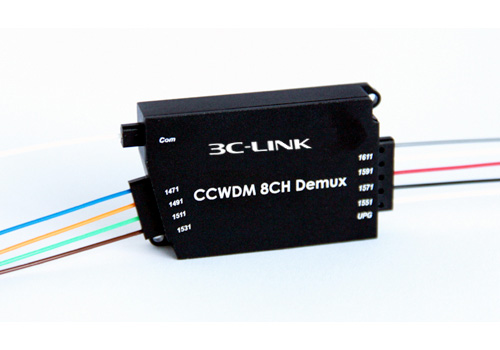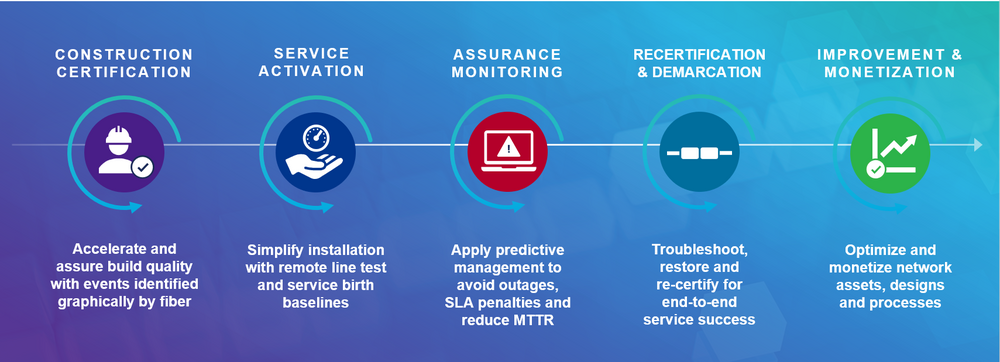
CCWDM Module

Fiber monitoring refers to the ongoing assessment of fiber quality with software tools and devices that comprise an integrated fiber monitoring and management system. These elements collectively facilitate the detection of faults, degradation, or security intrusions and alarm the system administrator in real-time when threats to fiber optic network integrity occur.
A remote fiber test system (RFTS) is comprised of optical fiber test heads that contain an OTDR, a switch, and processors to collect and transmit data from the tests for analysis. An RFTS can be a single fiber test head standing alone in the network performing tests on one cable location or a collection of these devices that test in concert with a management server that produces network wide fiber network analytics, alarms and manages user access for network domains, regions or teams. The suite of test commands, results and analytics are typically accessed via a secure web browser application on a laptop or mobile application.
Monitoring systems can also be utilized to proactively trend and analyze attenuation and other fiber optic performance metrics over time.
An RFTS can be used during all phases of the fiber lifecycle from cradle to grave. Before the network is in service or "lit", such a system can be used for volume bases testing in a network using PON or DWDM or CWDM to test the fiber cables and network construction. The RFTS is connected at the exchange location in a PON network or at the end of a large cable to detect and locate all fiber faults. The system can maintain expected network inventory and record actual as built inventory as the network is tested. Once the network is put into service, it can be used for service activation and monitoring. The 3C-LINK (Optical Network Management Solutions) Family scales for all types of fiber networks from a single fiber, up to a network wide system that conducts millions of on demand test, service certification and automated monitoring transactions a day.

Optical cabling supports the communication infrastructure of our connected planet. Inherently fragile by nature, this same optical cable is susceptible to water ingress, misplaced construction digs, rodent infestations, security intrusions, and many other potential hazards. Maintaining optimal fiber condition and performance requires advanced fiber monitoring practices to identify and react to problems quickly.
New technology and network expansion continue to push the boundaries of fiber optic monitoring capabilities. Submarine cables are extremely long fiber optic runs laid in trenches on the ocean floor, installed by specialized ships at a rate of 200 kilometers or more per day. While the value of these optical fiber runs is obvious, the expense of installing and maintaining them can be considerable. When problems occur, divers or robotic vessels may be required to investigate and repair defects. Robust fiber monitoring can lead to earlier detection and precise locating capability, thereby reducing reaction and repair times.
Fiber optics continue to usurp the territory once dominated by conventional coaxial cabling and telephone wires. Fiber to the home (FTTH) is now becoming more common, with direct fiber optic runs to individual homes enabling higher bandwidth and improved data integrity for users. Extending the reach of fiber optics is inevitable, so fiber optic monitoring systems must now be capable of accurately detecting fiber faults from the source all the way to the subscriber.
All fibers remain physically dark while they are not in use for live traffic in which data is sent via light pulse down the line. A cable might have spare fibers in reserve capacity, or a service provider may have installed a PON residential network, and the fiber is available for service, but some fibers aren’t yet subscribed by a customer. In this case, a branch of the network remains dark or unused until a subscription for internet service is contracted. The internet service provider (ISP) or wholesale network operator, will want to periodically test this section that is unsubscribed, or dark, using a test pulse to ensure it’s ready for service.&
The term dark fiber in telecom used to mean the fiber was laid but not used. However, the current meaning is that the owner is not using it for data transmission and is instead leasing it out to another service provider, infrastructure provider or user. The dark fiber provider business is booming. Such a provider might build a fiber network for lease and the company that leases it will place the fiber in service and control the transmission over that fiber, commonly using DWDM transmission wavelength channels to boost capacity.
The fiber may be subterranean or aerial, but it is still subject to damage from weather, animals, human error, and construction digging known fondly as backhoe attenuation. It needs to be periodically scanned or monitored so that it is ready for service when leased and will meet the service level agreement (SLA) specifications for fiber health and performance, latency etc.
A dark fiber provider can monitor their fiber, or their customer can monitor the fiber and these responsibilities are included in the contract. However, often the customer has more to lose if the fiber goes down and they will monitor it for issues to enforce their SLA. While the company using the dark fiber has control over the transmission, the fiber may still be disrupted if someone is in a fiber cabinet and disconnects the fiber or bends the fiber as the dark fiber owner goes about maintenance of their fiber assets for multiple customers.
Demarcation: Dark fiber routes are joined together in mixture of own vs. lease configurations. The customer of the dark fiber provider benefits by using existing fiber network lines that can take years to build. As these are put into service, they must be qualified to ensure they meet standards. Consider an own, lease, own, lease, own configuration for a company creating a cross country route between a data center in Oregon, Denver, and Virginia. Demarcating the network section where a fault has developed and ensuring that the right team is dispatched to the location for preventative maintenance is critical. Should the network be unavailable due to a break, it is critical to locate this precisely and enforce the SLA for restoration. Penalties for the dark fiber or ethernet fiber line outage will be steep and amount to millions a year so monitoring provides ROI for both the dark fiber provider asset owner and the leasing company that has placed that fiber into use.
The Physics of Dark Fiber Test vs. Lit Fiber Test
How is testing different when there is live traffic vs. no traffic? When introducing a test light pulse into a physically dark, unused network, there is no interference with live traffic light pulses that are carrying data. We can test at any wavelength without risk. However, in an active, lit fiber network carrying traffic, we need to inject our test light pulse at another wavelength that is out of the bandwidth in use for communication to preserve capacity for traffic and to avoid causing delays or congestion at the traffic wavelength. For both PON P2MP and active DWDM P2P networks, 1625 and 1650 nm wavelengths are typically used for the test signal to eliminate any interference to the traffic or active devices such as receivers, amplifiers, etc.
In a long-distance point-to-point active network, there will be amplification and routers to perpetuate the traffic light pulse across the distance, to overcome the natural attenuation or loss of signal that degrades over long distances. We often need to divert our test signal around these active devices to prevent traffic disruption, errors in the test and impact to the devices by using a filter to remove the test signal and route it around the active devices with a jumper cable or to remove the signal totally.
Fiber optic security concerns have become increasingly relevant as more intrusions and data theft incidents are reported each year. Although fiber optic cabling is generally perceived as being more secure than conventional cabling, fiber-tapping incidents continue to challenges authorities and fiber monitoring system capabilities.
Tapping techniques, including the introduction of optical splitters or fiber bending to induce leaks, have continued to evolve to elude detection. Encrypting data is an obvious first line of defense for such intrusions, but fiber monitoring technology can also be used to identify the shifts in optical feedback that the perpetrators seek to disguise.
One innovative approach to fiber monitoring that can improve security with minimal additional hardware infrastructure is active fiber monitoring (AFM). By detecting small changes in light transmission across active fiber lines, alarms can be raised so that appropriate security measures can be taken. Using AFM, it is not necessary to dedicate additional fibers for monitoring purposes, since active fibers already carrying high priority data can be strategically selected for observation.
A remote fiber test system (RFTS) enables the oversight of an entire fiber optic network, including dark fiber, from a central location. Using this comprehensive method, the performance of the network can be continuously evaluated, and mean time to repair (MTTR) can be minimized.

MTTR is the measure which best encompasses the overall effectiveness of a fiber monitoring and management system. This is simply the average amount of time required to troubleshoot a failure and return the system to working order. The repair and troubleshooting process is made up of the “find" or fault localization process and the repair process. When a major break or bend event occurs, often 4-5 technicians are dispatched over 4-5 hours to find the problem before the fix can be made. Remote monitoring reduces the localization portion of the repair process to less than five minutes and is done remotely and automatically. This is typically 30-40% of the full span of the repair process timeframe. Thus the accuracy of remote fiber monitoring, utilizing OTDR technology to pinpoint fiber faults, is one key to minimizing MTTR and improving user satisfaction.
Alert messages produced by remote fiber optic monitoring systems can be communicated via email, as well as SMS or SNMP protocols. SMS messages are simply out-of-band text messages that are automatically pushed out to the appropriate users when alarms occur. This can minimize the need for constant oversight of monitoring interfaces. Simple Network Management Protocol (SNMP) is another communication tool that is commonly used to monitor devices remotely and relay alerts to a central location or host.
Despite the effectiveness of OTDR technology, the existence of dead zones in fiber optic links are a potential source of fiber monitoring uncertainty. A dead zone in an OTDR measurement can occur when there is a high reflectance event in the fiber line. This can be caused by air gaps, splices or connectors that produce a sufficient level of reflectance to temporarily saturate the OTDR detector.
During this “black-out” period while the detector is recovering from the saturation, the OTDR will not be capable of accurately discerning other nearby events in the fiber line. This becomes important when a fault condition arises close enough to an existing splice or connection such that a new issue is obscured by a pre-existing reflectance source.
Another common component of fiber optic networks that can lead to challenges as well as opportunities is the prevalence of dark fiber. Despite the ominous-sounding moniker, this term simply refers to the presence of unused or “unlit” fiber in the network. This descriptor is also sometimes used to describe fiber optic cables that are leased from the original carrier to another party.
This dark fiber still requires testing and monitoring to ensure integrity, particularly if the fiber is designated for future expansion opportunities. The presence of unused, terminated fibers can sometimes prove advantageous for monitoring. Fault conditions will usually affect all fibers in a cable, so monitoring of selected dark fibers is an effective way to continually verify the cable integrity without disrupting the active fibers.
As the reach and bandwidth of fiber optic cabling continues to progress, the need for accurate and comprehensive fiber monitoring systems will expand as well. Innovative P2MP network architecture including passive optical networks (PON) will enable more FTTH with lower power consumption and less potential for electrical interference. The expected increases in optical fiber network complexity will make fiber monitoring more important than ever.
Innovations that continue to improve OTDR accuracy and performance over short cable runs will inherently benefit fiber optic monitoring systems, reducing the impact of dead zones and other artifacts that can be exploited by fiber tappers. Maintaining the security of fiber optic networks is imperative, so fiber monitoring technology of the future must constantly evolve to stay one step ahead of these challenges.
check PDF for detail

Copyright © 2022 3c-link Corporation Limited.VOKO提供网站技术支持
Privacy Policy